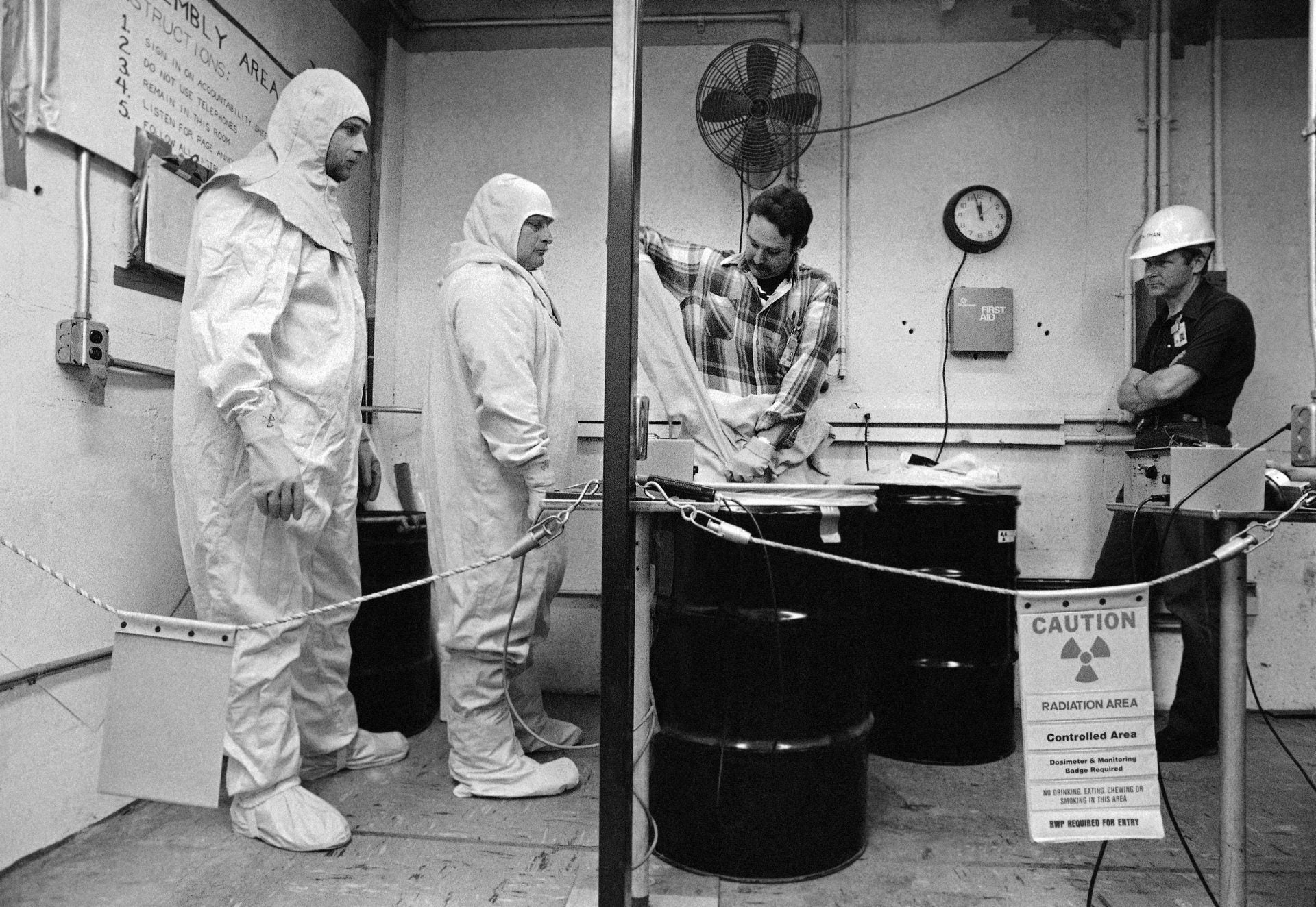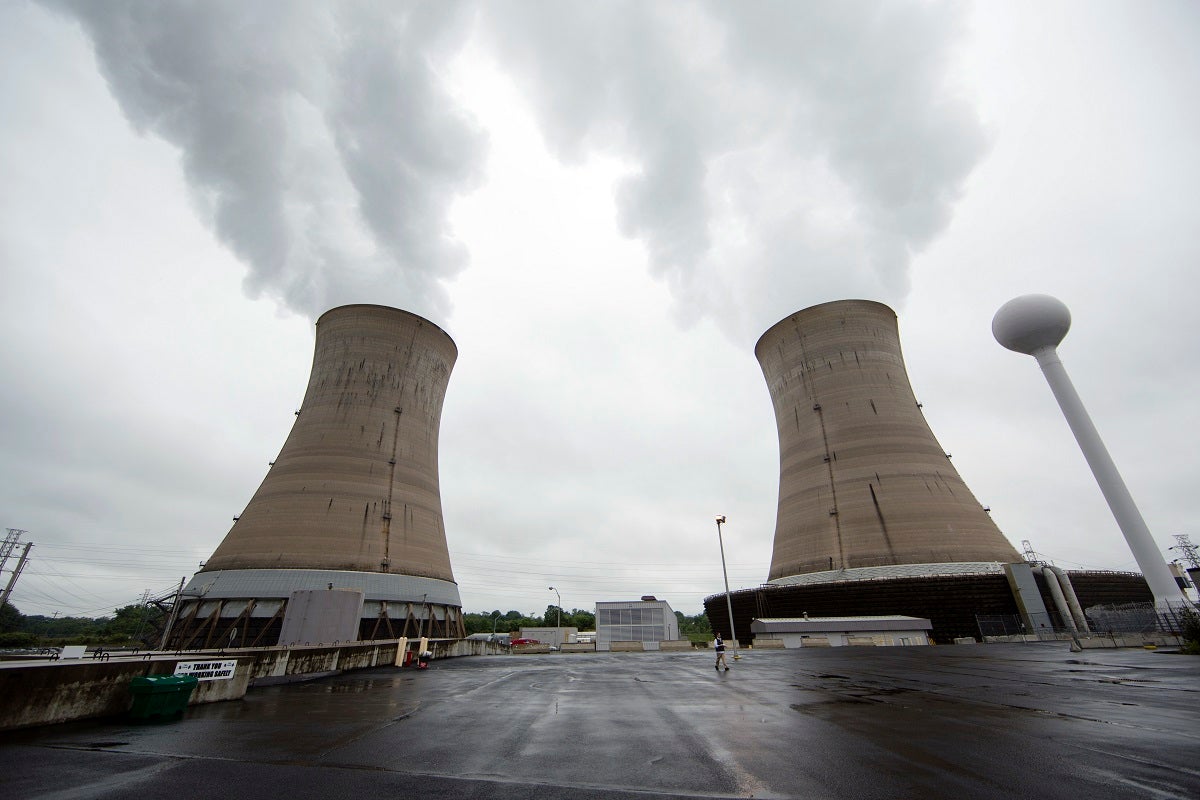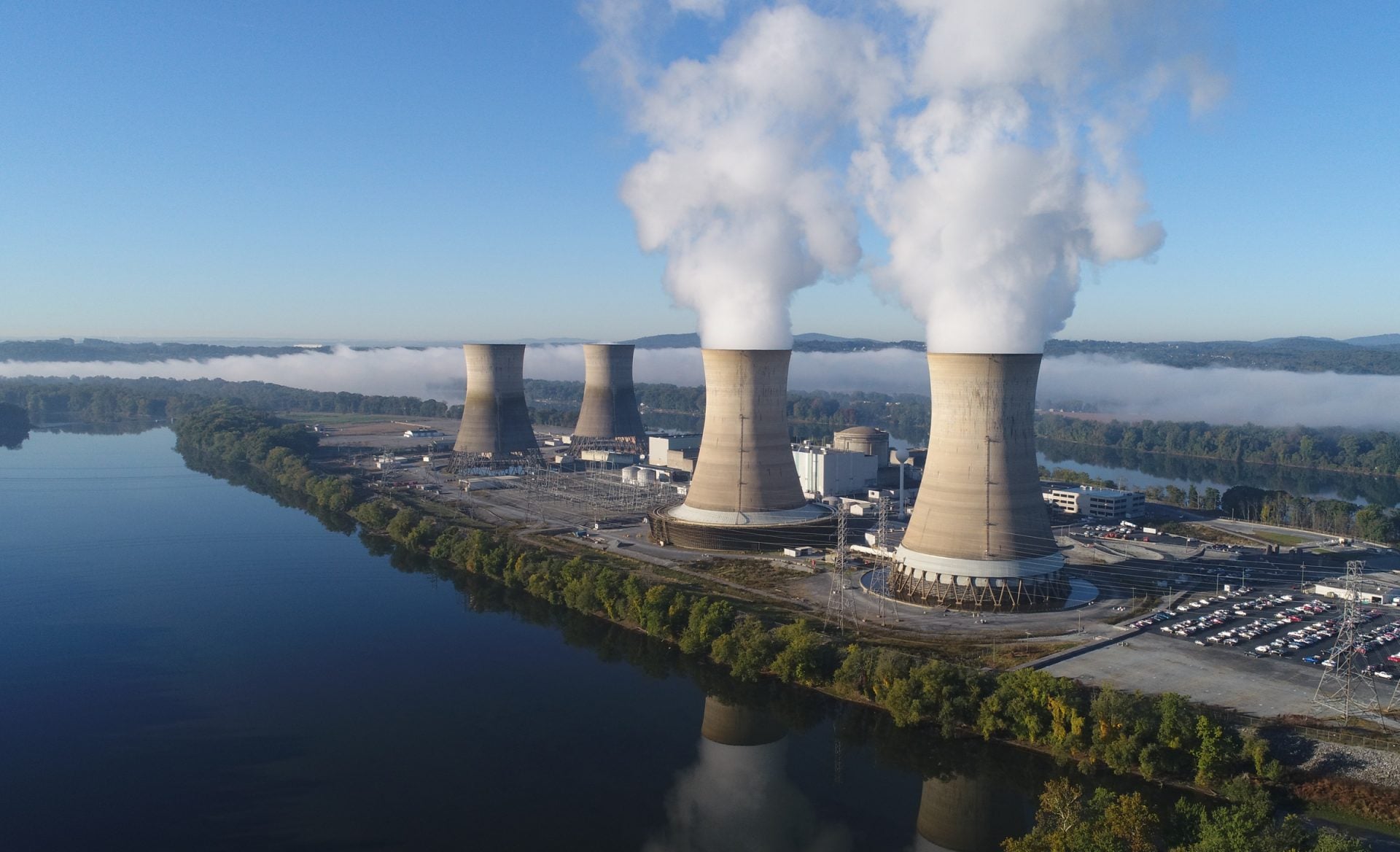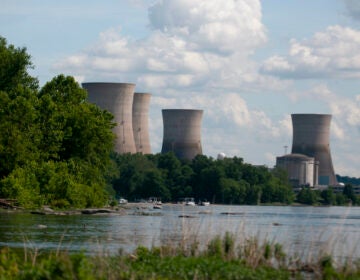What will become of Three Mile Island’s nuclear waste if the plant closes?
"Nobody wants the spent fuel near them," said Don Hudson, who lives downstream from the defunct Maine Yankee plant.

In this May 22, 2017, file photo shows the control room at the Three Mile Island nuclear power plant in Middletown, Pa. Forty years after Three Mile Island became synonymous with America's worst commercial nuclear power accident, the prospect of bailing out nuclear power plants is stirring debate at the highest levels of Pennsylvania and the federal government. (Matt Rourke/AP Photo)
This story originally appeared on PA Post.
—
Three Mile Island’s short-term survival currently rests with Harrisburg lawmakers and lobbyists but the storied nuclear power plant’s ultimate fate is already known: It will eventually be decommissioned and, for now at least, its radioactive waste will be stored on site for years to come.
The specifics are still murky but the outcomes of other shuttered reactors illustrate a long and often fraught process. In decades past, spent fuel and other contaminated materials were shipped to federal compounds where they were warehoused or buried underground. Growing health and environmental concerns put a stop to that practice, resulting in radioactive elements being stored at dozens of reactors across the country.
“Nobody wants the spent fuel near them,” said Don Hudson, who lives downstream from the defunct Maine Yankee plant and chairs its community advisory panel. “It’s the biggest NIMBY on the planet and nobody wants to deal with it.”

Indefinite storage
For decades, federal officials sought a location to serve as a permanent repository — one remote, secure and stable enough to avoid calamity or widespread contamination. Yucca Mountain in southern Nevada was designated as just such a place in 1987 but it faced numerous setbacks and was abandoned by the Obama administration in 2011. The Trump administration sent mixed signals in its first two years. The president’s 2020 budget proposal asked Congress for billions of dollars to restart the project. If Congress approves, the repository would still be years (and potentially decades) in the making.
In the absence of a long-term solution, the country’s nuclear power plants are left with one option: indefinite on-site storage.
That’s what will happen at Three Mile Island, where Exelon plans to build an interim spent fuel storage installation (ISFSI) that will hold spent fuel in the middle of the current plant, between the two units’ cooling towers. As of 2017, the first phase of that project was expected to cost $85 million.
NRC spokesman said Neil Sheehan said the groundbreaking is now expected to begin in 2020. Dry casks, which contain radioactive material that has been cooled in a pool for at least one year and surrounded by inert gas, could be moved into the ISFSI in 2021.
Ed Callan, TMI’s site vice president, previously told PennLive that the plant was fitted with a large pool that has housed the spent fuel from Unit 1 since it was commissioned in 1974. The fuel storage installation will be built whether or not TMI is decommissioned because the pool is projected to run out of space in 2023.
Once the ISFSI is completed, Callan said TMI would be able to begin placing spent fuel from the pool for at least five years into the thick stainless-steel casks. They would then be sealed inside an above-ground concrete encasement.
“Basically, you’re keeping them out of the environment,” he said. “They can take a lot of punishment . . . and they have a capability to stand for a long time.”
The stainless-steel casks, which weigh about 100 tons a piece, contain any radiation emitted from the fuel. The dry cask process isn’t required by law but has become standard across the industry.
“If you go to Limerick or Peach Bottom, you could stand right next to the concrete,” Callan said, in 2017. “You’re not going to get a minimal dose of anything.”
The glut of cheap gas that flooded the market due to the Marcellus Shale boom combined with increasing operating costs to undermine nuclear facilities across the country. Exelon reported losing some $300 million over the last decade and has lobbied Pennsylvania lawmakers for subsidies that would put it on better footing against natural gas when selling power to the electrical grid.
Exelon announced plans to close TMI two years ago, although its tentative 2019 shutdown date could be reversed if its lobbying succeeds. And the decommissioning process means TMI will continue to be staffed—although not at the current level of roughly 650 employees—for many years to come.
As of December 2017, the company reported having $707,000 in a federally mandated decommissioning trust fund. Based on an NRC formula, it would need $478,000 to shut down the plant and remove any radiological contamination. It’s possible—and, indeed, likely—the actual cost will be greater.
“We will know more if the company moves ahead this year to permanently shut down the plant,” Sheehan said.
Assuming Exelon follows through with its shutdown plans, the company would have two years to submit a document that outlines its specific decommissioning plans and cost estimates.
TMI-2, which is owned by First Energy, had $834,000 in its decommissioning trust fund as of December 2017 against an estimated $1.3 billion in costs, based on the NRC’s formula.

‘Where else?’
Nuclear power, a byproduct of World War II military research, was a modern scientific marvel expected to drive post-war prosperity with electricity that was “too cheap to meter.”
President Dwight D. Eisenhower captured this optimism in a 1958 speech at the opening of the Shippingport Atomic Power Station, located just north of Pittsburgh and the first of its kind worldwide: “The power of the atom will be able to open up a vast new world of peaceful development,” he said. “That atomic power will ease mankind’s burdens and provide additional comforts for human living.”
Nuclear’s advantages were clear: Fission, or the splitting of atoms resulting in intense heat energy, created a stable flow of inexpensive electricity without the greenhouse gases or toxic soot associated with coal or gas-fired plants. But it presented a problem that still confounds engineers and policymakers today: What should we do with the radioactive fuel and the equipment it comes in contact with once the fuel or the plant around it reaches the end of their useful lives?
Shippingport, which was far smaller than the commercial reactors that succeeded it, shut down in 1982. Back then, spent fuel and waste material was routinely reprocessed or simply buried underground at federal military facilities. By 1984, at least 2 million curies of spent fuel from Shippingport was transported to the Hanford nuclear production complex in Washington state, according to U.S. Department of Energy (DOE) reports.
Several years later, in 1989, a barge hauled Shippingport’s 150-ton reactor vessel down the Ohio and Mississippi rivers to the Gulf of Mexico, across the Panama Canal, up the Pacific Coast and to its final resting place in a 40-foot trench at Hanford. The 8,100-mile-long voyage made national headlines and officials declared the $98.3 million decommissioning (roughly $200 million in 2019 dollars) a success.
“I can honestly sit here and say this project went off without any major mistakes,” a DOE spokesman told The Boston Globe in 1992.
Today, there are few signs that Shippingport ever existed. The land could be redeveloped if not for the Beaver Valley Nuclear Power Station, whose two reactors opened nearby in 1976 and 1987. Beaver Valley’s owners, not coincidentally, declared their intention to close in 2021 if the state Legislature fails to act to bolster the nuclear industry.
“There was talk at the time of putting a park on [the Shippingport] site,” said Willis Shirk, a Lancaster-based author and archivist who studies the atomic space age. “When they built the other two right next door, it was in their security perimeter.”
Shippingport’s cleanup, however, came at the expense of those who live and work around Hanford. The facility manufactured plutonium used in the first atomic bomb detonated over Nagasaki in 1945 and, in the decades after WWII, became a dumping ground for radioactive material from across the country.
“It’s not something that Hanford would do these days,” said Tom Carpenter, executive director of the nonprofit Hanford Challenge, which advocates for the site’s cleanup. “At the time it was like, ‘Where else are we going to put it?’”
Following the partial meltdown at TMI-2, which is owned by First Energy, the fuel and other waste from the reactor was shipped to Hanford while the reactor core structure and other debris was shipped to the Nuclear Regulatory Commission’s Idaho National Laboratory for study.
Off-site waste was banned from Hanford in the early 2000s. In recent decades, dozens of workers reported being sickened and the DOE launched a cleanup that’s expected to take another 50 years and cost more than $100 million.
The DOE and its contractors are grappling with very real concerns the buried toxic waste could leach into the Columbia River or become dislodged by seismic activity. One of the trenches used to bury radioactive material collapsed in 2017, forcing an evacuation and diverting air traffic around the site.
Carpenter said Hanford contains some 42 linear miles of trenches. One of them, according to DOE documents, contains radioactive materials from Shippingport.
“Black lung is a fact of life in coal mining towns. At Hanford, it’s just radioactivity,” said Carpenter, who’s represented nuclear industry whistleblowers around the country. “After an exposure, it takes a while to get sick and you don’t know you’re being dosed.”

The best solution?
Maine Yankee bears some striking similarities to Three Mile Island—apart from the partial meltdown, of course.
That nuclear plant, located on a narrow strip of land beside the Black River, was the largest employer and taxpayer for Wiscasset, a quaint community along the Maine coast just south of the state capital of Augusta. By the time the plant closed in 1996, it was paying $13 million in property taxes, or 91 percent of the municipal tax base.
Some locals, including Hudson, looked askance at the plant out of fear of environmental calamity—even more so after the partial meltdown of TMI-2 in 1979. It was the subject of three separate referenda attempting to shut it down. A series of safety violations and rising maintenance costs ultimately forced its closure.
Maine Yankee’s decommissioning, which involved long-term, on-site dry cask storage, has been held up as an example of how it’s done right. So far, at least, nothing’s undermined that perception. TMI will follow Maine Yankee’s lead.
Hudson, a biologist who was appointed to the plant’s community advisory panel, was there for the entire process and sat in on many of the planning meetings.
The casks, he said, are well protected, with the radioactive material encased “like a thermos bottle” in two two-inch-thick steel containers inside a roughly four-foot-thick concrete casement.
“If it was hit by a plane,” he said, “there’d probably be a great big fireball but nothing much else would happen.”

Sea level rise could be a legitimate concern if the facility remains in place for decades or centuries (again, in the absence of a long-term storage facility).
“Flooding from upstream is moderated by the fact there’s a tide downstream amplifying and deamplifying water levels,” he said. “But the bottom of the casks are only 30 feet above corrosive salt water.”
All things considered, Hudson thinks it’s the best solution there is.
“As a die-hard tree hugger and environmentalist, I can say it’s safe and probably the safest way to handle the fuel in this state of limbo we’re currently in,” he said.
The rest of Maine Yankee has been demolished, leaving much of the site open for redevelopment. In practice, though, not much has come.
“So long as there’s a waste dump there, to put it bluntly, you’re not going to get a lot of people thinking that’d be a great place to build a factory,” he said. “We all have concerns about it, one way or another.”
Hudson, who was in high school when Maine Yankee was built, was initially vehemently opposed to nuclear power.
Now, he’s come around to the idea.
“If we have any chance at all of slowing the impact of rapidly changing climate and decarbonize the energy sector, we’ll have to use nuclear power,” he said.
Shirk, less surprisingly, is also a booster of nuclear power. He sees a missed opportunity in the warehousing of spent fuel across the country.
Advancements in processing radioactive material and in power station technology mean the material could be recycled and continue to produce power for years longer, he said. And it’s certainly more environmentally conscious than our increasing reliance on coal and natural gas-fired power plants.
“It seems like a very bad idea to simply leave them sitting there after decommissioning,” he said. “This is a case of not thinking things through on the part of the public and politicians.”
Carpenter, meanwhile, said there’s a certain logic to keeping radioactive material in dry cask systems scattered across the country. Unless the materials are being stored in a precarious location, such as a place prone to earthquake or tsunami-prone, it’s best to keep them in place and only move it once: to a permanent disposal location, whether that’s Yucca Mountain or somewhere else.
“If you collect this stuff in one location for storage that’s not a permanent disposal site, you’re going to have to keep moving it,” he said. “You put this on the roads, you can’t really shield the radioactivity. You’ll be irradiating cars, trucks and school buses going down the road.”
WHYY is your source for fact-based, in-depth journalism and information. As a nonprofit organization, we rely on financial support from readers like you. Please give today.




